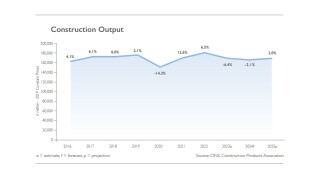According to the Construction Products Association (CPA) Winter Forecasts, published today, construction output is forecast to fall by 2.1% this year due to falls in private housing new build and repair, maintenance & improvement (RMI) – the two largest construction sectors.
The slowdown in private housing and RMI are both attributable to the rise in bank interest rates; the Bank of England rate has risen from 1% in June 2022 to 5.25% today. This has made mortgages more expensive and reduced consumer discretionary spending power for home improvements.
Six months ago the CPA was forecasting 0.7% growth for UK construction output in 2024. Three months ago, it changed this to a 0.3% contraction. That it is now forecasting a 2.1% contraction represents a significant further deterioration in sentiment.
The CPA forecasts that construction output will rise by 2.0% in 2025 on the basis that interest rates are expected to come down a little in line with falling interest rates.
(The Bank of England’s monetary policy committee expects the rate to decline gradually to 4.25% by the end of 2026.)
The CPA identifies recent disruptions in the Red Sea as a key risk to its forecasts, potentially leading to supply issues such as delays and accelerating cost inflation.
CPA economics director, Noble Francis said: “The bad weather at the start of January has already affected the construction industry but there is still lots of time for a catch up in activity when the weather improves. The bigger problems for the industry are the hits to activity last year in its two largest sectors – private housing and private housing RMI. These are likely to continue into 2024. Even with expected falls in interest and mortgage rates in the second half of this year, rates are likely to remain relatively high and so demand in the housing market, house building sector and RMI sector is likely to remain subdued overall.

“Given the importance of housing to the UK economy, it was disappointing that the chancellor’s autumn statement last year had little to help the beleaguered sector. It is critical that we see measures to help boost house building and homeownership from government in the upcoming spring budget. Furthermore, government should do more on infrastructure delivery given that the sector is set for its third consecutive fall in output. This is despite announcements from government on new projects to compensate for the cancelling of the Northern leg of HS2.”
CPA forecasts by sector
Private housing, the largest construction sector, suffered a double-digit fall in output in 2023 after a spike in mortgage rates hit housing market demand. Consequently, many house-builders have reported a fall of around 25-35% in demand, in addition to the regulatory issues that smaller house-builders continue to face in particular around planning, as well as water and nutrient neutrality. The lagged effect of higher mortgage rates is likely to continue to weigh upon property transactions this year with private housing output expected to fall by a further 4.0%.
Looking to 2025, a gradual fall in interest rates should boost demand with private housing output expected to rise by 4.0%. This doesn’t imply a speedy recovery, however, as interest and mortgage rates are not expected to return to the record lows seen as recently as 2021 anytime soon. The lack of a government policy stimulus to help overcome high deposit and mortgage payment requirements also means the recent peaks in house-building from 2022 are unlikely to be seen again until at least the end of the decade, the CPA says.
Private housing RMI is the second-largest construction sector and activity continues to be on a general downward trend. The rising cost of living has hit discretionary household improvements spending. In addition, fewer property transactions last year led to a decline in refurbishment activity from new homeowners who typically make cosmetic improvements within the first six to nine months of moving in. Smaller project work is likely to continue to remain flat in the first half of this year as household spending remains tight, while the continued fall in property transactions in the first half of this year is likely to hit larger project work for the remainder of 2024. This is likely to be partially offset though by strong activity on energy-efficiency retrofit such as insulation and solar photovoltaic work. Overall, private housing RMI output is expected to fall by 4.0% in 2024 before growth of 3.0% in 2025.
In infrastructure, the third-largest construction sector, activity remains strong, with HS2, Hinkley Point C and the Thames Tideway Tunnel, as well as sustained in the regulated sectors of roads, rail, water and electricity. However, the CPA says that concerns remain over pauses and delays to National Highways projects, as well as increasing uncertainty on the deliverability of plans in the water sector to deal with water quality issues through increased capital expenditure. Furthermore, at a local level, councils continue to face financial constraints and despite government announcing £8.3bn of funding for potholes, resurfacing and local roads projects to 2034, there is little evidence to suggest that this will lead to any uplift over the forecast period, the CPA says. As a result, overall, infrastructure output is expected to fall by 0.5% in 2024, a third successive marginal fall in output, before rising by 1.2% in 2025.
Got a story? Email news@theconstructionindex.co.uk




